NEW KEN BURNS FILM EXPLORES HISTORY OF THE AMERICAN BUFFALO
Two-Part, Four-Hour Film Traces the Near Demise – and Ultimate Return – of the U.S. National Mammal, While Examining the Species’ Connection to Indigenous Communities and the Land.
Commentary and Perspectives Provided by Authors N. Scott Momaday, Steven Rinella and Michael Punke; Historians Sara Dant, Rosalyn LaPier, Dan Flores and Elliott West; and Tribal Nation Members George Horse Capture, Jr., Marcia Pablo, Gerard Baker and Dustin Tahmahkera, Among Others.
THE AMERICAN BUFFALO is the biography of an improbable, shaggy beast that has found itself at the center of many of the country’s most mythic and heartbreaking tales. The series, which has been in production for four years, will take viewers on a journey through more than 10,000 years of North American history and across some of the continent’s most iconic landscapes, tracing the mammal’s evolution, its significance to the Great Plains and, most importantly, its relationship to the Indigenous People of North America.
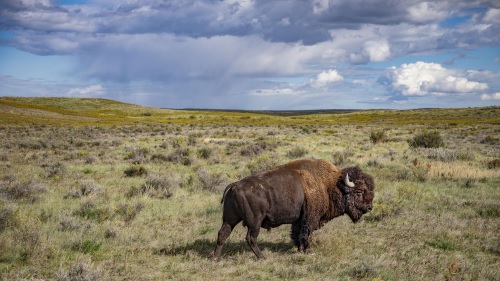
“It is a quintessentially American story,” Ken Burns said, “filled with unforgettable stories and people. But it is also a morality tale encompassing two historically significant lessons that resonate today: how humans can damage the natural world and also how we can work together to make choices to preserve the environment around us. The story of the American buffalo is also the story of Native nations who lived with and relied on the buffalo to survive, developing a sacred relationship that evolved over more than 10,000 years but which was almost completely severed in fewer than 100.”
The series was written by Dayton Duncan (COUNTRY MUSIC, THE DUST BOWL, THE NATIONAL PARKS, LEWIS & CLARK), who is also the author of the companion book, “Blood Memory: The Tragic Decline and Improbable Resurrection of the American Buffalo,” to be published by Knopf timed to the broadcast. It was produced by Burns’ longtime colleague Julie Dunfey (COUNTRY MUSIC, THE NATIONAL PARKS, THE DUST BOWL, THE CIVIL WAR). Julianna Brannum (CONSCIENCE POINT, NATIVE AMERICA, WE SHALL REMAIN “Wounded Knee”), a member of the Quahada band of the Comanche Nation of Oklahoma, served as consulting producer. W. Richard West, Jr., a Cheyenne and founding director and director emeritus of the Smithsonian Institution’s National Museum of the American Indian, was the senior advisor.
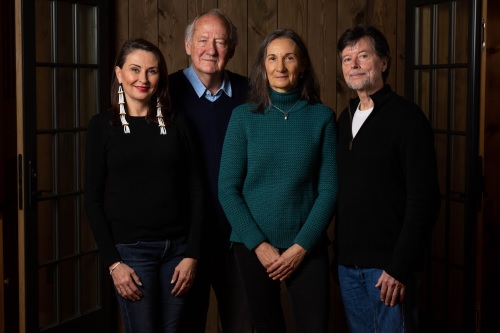
(Steve Holmes Photography)
During a TCA press tour which included, Julianna Brannum, Series Consulting Producer, Ken Burns, Series Director, Julie Dunfey, Series Producer, and Rosalyn LaPier, Historian and Series Participant and media, these four answered questions about the upcoming documentary. Ken started off thanking everyone for joining in on the conversation and said “happy to be participating in that discussion with my coproducer Julie Dunfey; our consulting producer Julianna Brannum, who is a member of the Comanche Nation; and, also, with the scholar/historian Rosalyn LaPier, who is a member of the Blackfeet Métis. He went on to say that this project that Julie and he had been thinking about, along with writer Dayton Duncan, for more than three-and-a-half decades. He said is was happy that it took them that long to make the film because he thinks we all could benefit from new scholarships, which Rosalyn has published. He was excited to have found new archives to help advance the story of the American buffalo from just a parable of de-extinction.
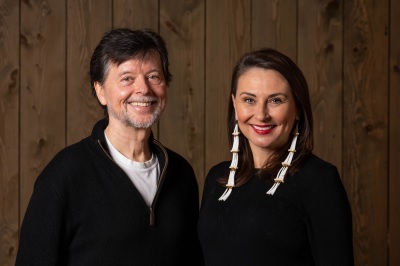
A question was asked about how long did it take to film the series and where was it film.

Julie Dunfey said that they started filming in May of 2020. They had a full year to do additional research and meeting more people. Once they started production in May of 2021, they had to do 18 months of production work in six months between May and October. WOW! She said their interviews were up and down the northern and southern Plains. They filmed in Montana, Texas, Oklahoma, and South Dakota. Julie also said that she got in touch with a lot of different wildlife cinematographers, who were able to go out in their backyard without having to fly or stay in a hotel and do some filming with them.
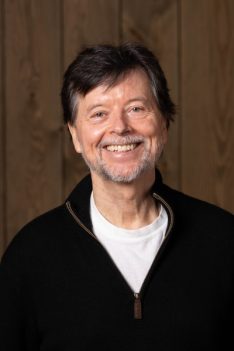
I really like what Ken Burns said about this documentary. Ken Burns: “The first episode is, at times, incredibly difficult to watch when you watch a species that numbered perhaps as many as 50 or 60 million, we had no way of knowing, dwindles down over the course of the 19th century to the mid-80s, down to under a thousand and most of them are in zoos or in private herds and not running wild and free. And so the fact that we have brought the bison back from extinction is itself an accomplishment. But we’ve begun to see, as we were finishing the film, that the film we were making was really the first two acts of the three-act play, if you will, because at the end of the day to save a species as a zoo animal or as an exhibition animal in a corral isn’t the same as saving them as wild and free, and that’s now going on. And, in some way, the last minutes of the film sort of suggest what that third act will be, which is a wonderful unison of private citizens, the federal government who controls upwards of 20,000 head right now in national parks and various wildlife refuges, Native peoples who have well more than 20,000 distributed among more than 80 tribes coordinated by the Intertribal Buffalo Council, which is repatriating buffalo to tribes that have not just been disconnected for the last 150 years from this animal central to their existence for 10-, 12,000 years, but have been separated for (two?) or 250 years. It’s a very moving thing. And Julianna has made a wonderful film that’s going to accompany ours called “Homecoming,” and one of the scenes in it is the repatriation of buffalo to the Menominee, which is a tribe in Wisconsin, and to look in the buffalo’s eyes and look in the tribal members’ eyes and see that recognition across the centuries, the millennium, is an amazing thing.”
So well said Ken! As he said, the first episode is a difficult one, I cried and I was not proud to be an American at that point. Although it is difficult to watch, please do watch this incredible documentary, because not matter what, it is history and history is important for everyone, especially the younger generation. We must all try and help to keep the American Buffalo truly free in America! Ken Burns has done it again, brought us yet another amazing historical documentary. So don’t miss this beautiful, amazing and historical documentary next Monday and Tuesday, October 16 & 17 on PBS. Judy Shields, The Hollywood Times
Rosalyn Lapier said that she would speak from tribes’ perspectives about the return of the American Buffallo. She said “tribes right now are returning bison to their communities, and they’re doing that for a couple of different reasons. One is for spiritual reasons and for spiritual practice, but the other is because of food sovereignty reasons. Reintroducing bison back into our food systems, reintroducing bison back into our school systems. And so we’re seeing this now in a lot of tribal communities where tribes are reintroducing bison back into school systems where kids are now — it’s an option now within our public schools for them to eat bison. We also have it now, for example, on my home reservation, on the Blackfeet reservation, our tribe also butchers our own bison, and we can either buy that in a local grocery store, or if people are low income they can get it through our system of food that we share with elders and with others who are low income. So either way, like sort of any income bracket that people are in, they’re able to add bison back to our food system. So I think it’s a great thing to be able to eat bison. So I know that the bison that most people eat at, for example, at a restaurant is coming from a ranching system, and I see no problem with that because I think just sort of the more people start thinking about and adding bison back into our food systems the better.”
For thousands of generations, buffalo have evolved alongside Indigenous people who relied on them for food and shelter, and, in exchange for killing them, revered the animal. The stories of Native people anchor the series, including the Kiowa, Comanche and Cheyenne of the Southern Plains; the Pawnee of the Central Plains; the Salish, Kootenai, Lakota, Mandan-Hidatasa, Aaniiih, Crow, Northern Cheyenne and Blackfeet from the Northern Plains; and others.
The film includes interviews with leading Native American scholars, land experts and Tribal Nation members. Among those interviewed were Gerard Baker (Mandan-Hidatsa), George Horse Capture, Jr. (Aaniiih), Rosalyn LaPier (Blackfeet of Montana and Métis), N. Scott Momaday (Kiowa), Marcia Pablo (Pend d’Oreille and Kootenai), Ron Parker (Comanche), Dustin Tahmahkera (Comanche) and Germaine White (Confederated Salish and Kootenai Tribes).
“The story of American bison,” historian Rosalyn LaPier says in the film, “really is two different stories. It’s a story of Indigenous people and their relationship with the bison for thousands of years. And then, enter not just the Europeans, but the Americans…that’s a completely different story. That really is a story of utter destruction.”
THE AMERICAN BUFFALO documents the startling swiftness of the species’ near extinction in the late 19th century. Numbering an estimated 30 million in the early 1800s, the herds began declining for a variety of reasons, including the lucrative buffalo robe trade, the steady westward settlement of an expanding United States, diseases introduced by domestic cattle and drought. But the arrival of the railroads in the early 1870s and a new demand for buffalo hides to be used in the belts driving industrial machines back East brought thousands of hide hunters to the Great Plains. In just over a decade the number of bison collapsed from 12-15 million to fewer than a thousand, representing one of the most dramatic examples of our ability to destroy the natural world. By 1900, the American buffalo teetered on the brink of disappearing forever, and the Native people of the Plains entered one of the most traumatic moments of their existence.

Credit: Smithsonian American Art Museum
But the other, lesser-known part of this story, told in the film’s second episode, is about the people who set out to save the species from extermination and how they did it. Their actions provide compelling proof that we are equally capable of pulling back from the brink of environmental catastrophe if we set our minds to it.
Both parts of the larger narrative are filled with unforgettable stories and people, including Old Lady Horse, a Kiowa woman who describes her tribe’s spiritual and practical relationship with the bison, and Charles Jesse “Buffalo” Jones, a mercenary hunter who took part in the elimination of 3 million buffalo, then turned to rescuing motherless calves and starting a small herd that would eventually provide seed stock for others. The eloquent words of Pretty-Shield, a Crow medicine woman, describe the utter devastation felt by all the tribes at the destruction of the great herds, while crusading conservationist George Bird Grinnell’s editorials explore how central Yellowstone National Park’s small herd became to the survival of the species.
The buffalo were brought back from the brink of extinction by a diverse and unlikely collection of Americans, such as Native American families on reservations in South Dakota and Montana, the legendary cattleman Charles Goodnight and his wife Molly in the Texas Panhandle, and Austin Corbin, the Long Island railroad magnate who owned an exotic game preserve in New Hampshire. There was also Ernest Harold Baynes, an eccentric nature writer, who trained a pair of young bison bulls to pull a wagon and took them on tour to help launch a national movement to save the species. Other, more famous champions of the movement included the Bronx Zoo’s William T. Hornaday; William “Buffalo Bill” Cody; and Theodore Roosevelt, who hurried west as an impulsive young man to shoot a bison before they were all gone, and then, as president of the United States, created the first federal bison reserves in the West. The film also introduces Quanah Parker, the Comanche leader who went from waging war against the U.S. Army and the hide hunters to a man of peace, who lived to see the buffalo return to his homeland.
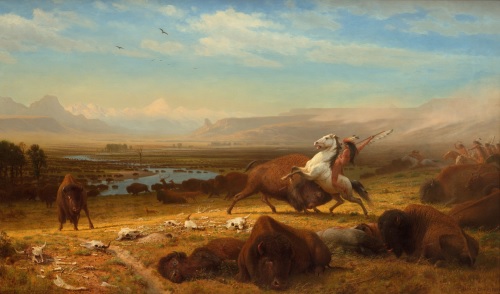
Courtesy National Gallery of Art, Washington, DC.
Today, there are approximately 350,000 buffalo in the U.S., most of them descendants of 77 animals from five founding herds at the start of the 20th century, and their numbers are increasing. THE AMERICAN BUFFALO concludes with a brief look at some of the ongoing restoration efforts and the central role the Tribal Nations have had in their return.
The broadcast of THE AMERICAN BUFFALO will be accompanied by educational materials for middle and high school classrooms, highlighting recent research and perspectives. The materials, which were prepared by PBS Learning Media, will be available at the Ken Burns in the Classroom site. These materials include clips from the film as well as other resources that connect to its core themes, such as reflections on the buffalo by Indigenous people, Native American life throughout the period, an examination of the buffalo ecosystem and others. UNUM, Ken Burns’s website that looks at the connections between the past and current events, will also utilize other films from the Florentine Films library to facilitate conversations about environmental change and the extermination of wildlife in the United States.
THE AMERICAN BUFFALO will air Oct. 16 and 17, at 8:00-10:00 p.m. ET (check local listings) on PBS, PBS.org and the PBS App. THE AMERICAN BUFFALO will be distributed internationally by PBS International. The series will be available to stream on all station-branded PBS platforms including PBS.org, the PBS App, available on iOS, Android, Roku streaming devices, Apple TV, Android TV, Amazon Fire TV, Samsung Smart TV, Chromecast and VIZIO. THE AMERICAN BUFFALO will also be available to stream on PBS Passport and the “PBS Documentaries Prime Video Channel”. PBS station members can view the documentary via PBS Passport as part of a full collection of Ken Burns films. For more information about PBS Passport, visit the PBS Passport FAQ website.
Voice actors in the film are Adam Arkin, Tantoo Cardinal, Tim Clark, Tokala Clifford, Jeff Daniels, Hope Davis, Paul Giamatti, Murphy Guyer, Michael Horse, Derek Jacobi, Gene Jones, Carolyn McCormick, Craig Mellish, Jon Proudstar, Chaske Spencer and Richard Whitman.
THE AMERICAN BUFFALO is a production of Florentine Films and WETA Washington, D.C. Directed by Ken Burns. Written by Dayton Duncan. Produced by Julie Dunfey and Ken Burns, and co-produced by Susan Shumaker. Emily Mosher served as associate producer and Julianna Brannum as consulting producer. Edited by Craig Mellish, ACE; Alex Cucchi, assistant editor. Principal cinematography by Buddy Squires. Narrated by Peter Coyote. The executive in charge for WETA is John F. Wilson. Executive producer is Ken Burns.
Corporate funding for THE AMERICAN BUFFALO was provided by Bank of America. Major funding was provided by the Corporation for Public Broadcasting, and by The Better Angels Society and its following members: The Margaret A. Cargill Foundation fund at the Saint Paul & Minnesota Foundation; Diane and Hal Brierley; The Keith Campbell Foundation for the Environment; John and Catherine Debs; Kissick Family Foundation; Fred and Donna Seigel; Jacqueline Mars; John and Leslie McQuown; and Mr. and Mrs. Paul Tudor Jones. Funding was also provided by The Volgenau Foundation.
ABOUT WETA
WETA is the leading public broadcaster in the nation’s capital, serving Virginia, Maryland, and the District of Columbia with educational initiatives and with high-quality programming on television, radio and digital. WETA Washington, D.C., is the second-largest producing-station for public television in the United States, with news and public affairs programs including PBS NEWSHOUR and WASHINGTON WEEK; films by Ken Burns, such as MUHAMMAD ALI and HEMINGWAY; series and documentaries by Dr. Henry Louis Gates, Jr., including FINDING YOUR ROOTS WITH HENRY LOUIS GATES, JR. and THE BLACK CHURCH: THIS IS OUR STORY, THIS IS OUR SONG; health content from Well Beings, a multiplatform campaign of engagement events and digital and broadcast content, including the documentary HIDING IN PLAIN SIGHT: YOUTH MENTAL ILLNESS; and performance specials including IN PERFORMANCE AT THE WHITE HOUSE and THE LIBRARY OF CONGRESS GERSHWIN PRIZE FOR POPULAR SONG. More information on WETA and its programs and services is available at www.weta.org. Visit www.facebook.com/wetatvfm on Facebook or follow @WETAtvfm on Twitter.
About PBS Documentaries Prime Video Channel
The PBS Documentaries Prime Video Channel is a DTC-SVOD channel exclusive to Prime Video. This channel features over 1,500 hours of the highest quality factual programming, including the full catalog of films from Ken Burns and award-winning documentaries from NOVA, FRONTLINE, AMERICAN MASTERS, NATURE, AMERICAN EXPERIENCE, in addition to programming from other independent producers.
Follow the PBS Documentaries Prime Video Channel on Facebook.
About PBS Passport
PBS Passport is a member benefit from participating PBS stations that gives eligible donors and supporters extended access to an on-demand library of quality public television programming online or within the PBS Video app. For more information about PBS Passport, visit the PBS Passport FAQ website.
About PBS
PBS, with more than 330 member stations, offers all Americans the opportunity to explore new ideas and new worlds through television and digital content. Each month, PBS reaches over 42 million adults on linear primetime television, more than 15 million users on PBS-owned streaming platforms, and 56 million people view PBS content on social media, inviting them to experience the worlds of science, history, nature, and public affairs; to hear diverse viewpoints; and to take front-row seats to world-class drama and performances. PBS’s broad array of programs has been consistently honored by the industry’s most coveted award competitions. Teachers of children from pre-K through 12th grade turn to PBS Learning Media for digital content and services that help bring classroom lessons to life. As the number one educational media brand, PBS KIDS helps children 2-8 build critical skills, enabling them to find success in school and life. Delivered through member stations, PBS KIDS offers high-quality content on TV — including a PBS KIDS channel — and streaming free on pbskids.org and the PBS KIDS Video app, games on the PBS KIDS Games app, and in communities across America. More information about PBS is available at PBS.org, one of the leading dot-org websites on the internet, Facebook, Instagram,




